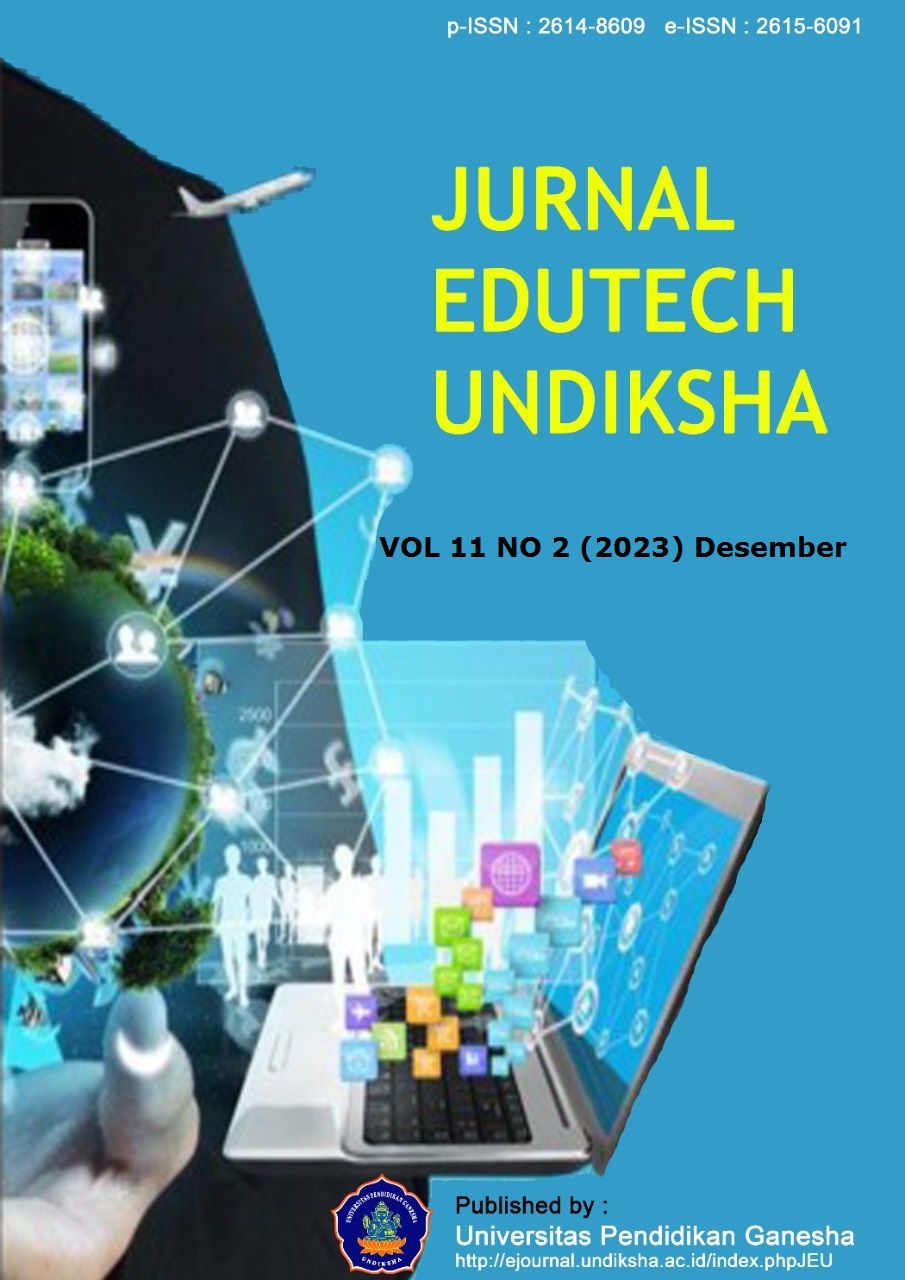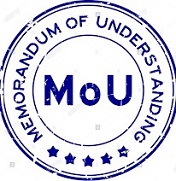Interactive Learning Multimedia Based on Indonesian Realistic Mathematics Education in Mathematics Subjects
DOI:
https://doi.org/10.23887/jeu.v11i2.63853Keywords:
Development, Interactive Learning Multimedia, Indonesian Realistic Mathematics EducationAbstract
The unavailability of media and learning methods used by teachers in learning mathematics is still simple, resulting in less understanding of students in learning and a decrease in the quality of learning, especially in mathematics subjects. This study aims to create interactive learning multimedia based on Indonesian realistiic mathematics education in grade IV mathematics subjects. This type of research uses development with the ADDIE model. The test subjects consisted of 3 experts and 12 fourth grade students. Data obtained with quantitative and qualitative data. The methods used were questionnaires and tests. Furthermore, the data were analyzed with descriptive qualitative techniques, descriptive quantitative and inferential statistics. Media feasibility is determined from the assessment results of learning content experts (91.66%), learning design experts (92.18%), learning media experts (88.33%), individual test results (87.38%), and small group test results (87.73%). So it is concluded that interactive learning multimedia based on Indonesian realistic mathematics education is feasible to be implemented in learning mathematics grade IV MI. This research has implications for the implementation of realistic and varied learning activities. The implication of this research is the increasing availability of learning tools, namely interactive learning multimedia according to student needs, able to increase student motivation in learning mathematics.
References
Andriani, R., & Rasto, R. (2019). Motivasi belajar sebagai determinan hasil belajar siswa. Jurnal Pendidikan Manajemen Perkantoran, 4(1), 80–86. https://doi.org/10.17509/jpm.v4i1.14958. DOI: https://doi.org/10.17509/jpm.v4i1.14958
Apriani, R., Harun, A. I., Erlina, E., Sahputra, R., & Ulfah, M. (2021). Pengembangan Modul Berbasis Multipel Representasi dengan Bantuan Teknologi Augmented Reality untuk Membantu Siswa Memahami Konsep Ikatan Kimia. Jurnal IPA & Pembelajaran IPA, 5(4), 305–330. https://doi.org/10.24815/jipi.v5i4.23260. DOI: https://doi.org/10.24815/jipi.v5i4.23260
Apriyanti, N., Razak, R. A., Rahim, S. S. A., Shaharom, M. S. N., & Baharuldin, Z. (2020). Infographic instructional media as a solution and innovation in physics learning for senior high school students in Indonesia. International Journal of Information and Education Technology, 10(10), 773–780. https://doi.org/10.18178/ijiet.2020.10.10.1457. DOI: https://doi.org/10.18178/ijiet.2020.10.10.1457
Ariani, R. (2019). Analisis Landasan Ilmu Pengetahuan dan Teknologi Pendidikan dalam Pengembangan Multimedia Interaktif. Jurnal Penelitian Pembelajaran Fisika, 5(2). https://doi.org/10.24036/jppf.v5i2.107439.
Badjeber, R., & Purwaningrum, J. P. (2018). Pengembangan Higher Order Thinking Skills. Jurnal Pendidikan Dan Pembelajaran, 1(1), 36–43. https://doi.org/10.31970/gurutua.v1i1.9. DOI: https://doi.org/10.31970/gurutua.v1i1.9
Chuseri, A., Anjarini, T., & Purwoko, R. Y. (2021). Pengembangan Modul Matematika Berbasis Realistik Terintegrasi Higher Order Thinking Skills (Hots) Pada Materi Bangun Ruang. Alifmatika: Jurnal Pendidikan Dan Pembelajaran Matematika, 3(1), 18–31. https://doi.org/10.35316/alifmatika.2021.v3i1.18-31. DOI: https://doi.org/10.35316/alifmatika.2021.v3i1.18-31
Diah Kurniawati, I., Nita, S., & dan. (2018). Media Pembelajaran Berbasis Multimedia Interaktif untuk Meningkatkan Pemahaman Konsep Mahasiswa. Journal of Computer and Information Technology, 1(2). http://e-journal.unipma.ac.id/index.php/doubleclick/article/view/1540. DOI: https://doi.org/10.25273/doubleclick.v1i2.1540
Dwi Saputra, A., Nurul Fauziah, F., Suwandi, S., & Artikel, S. (2022). Pemanfaatan materi ajar bahasa Indonesia bermuatan kearifan lokal di SMA Negeri 1 Karanganyar (Utilization of Indonesian language teaching materials containing local wisdom at SMA Negeri 1 Karanganyar. KEMBARA: Jurnal Keilmuan Bahasa, Sastra, Dan Pengajarannya, 8(2), 335–348. https://doi.org/http://ejournal.umm.ac.id/index.php/kembara. DOI: https://doi.org/10.22219/kembara.v8i2.21726
Fakhrurrazi, O. (2018). Hakikat pembelajaran yang efektif. Jurnal At-Tafkir, 11(1), 85–99. https://doi.org/10.32505/at.v11i1.529. DOI: https://doi.org/10.32505/at.v11i1.529
Faot, M. M., & Amin, S. M. (2020). Pengaruh Pendekatan Pendidikan Matematika Realistik Indonesia (PMRI) Terhadap Hasil Belajar Siswa. MATHEdunesa, 9(1), 55–60. https://doi.org/10.26740/mathedunesa.v9n1.p55-60. DOI: https://doi.org/10.26740/mathedunesa.v9n1.p55-60
Febriyanti, D. A., & Ain, S. Q. (2021). Pengembangan Modul Matematika Berbasis Etnomatematika Pada Materi Bangun Datar di Sekolah Dasar. Jurnal Basicedu, 5(3), 1409–1417. https://doi.org/10.31004/basicedu.v5i3.933. DOI: https://doi.org/10.31004/basicedu.v5i3.933
Fitra, D. (2018). Penerapan Pendidikan Matematika Realistik Indonesia (PMRI) dalam Pembelajaran Matematika. Jurnal Inovasi Edukasi, 1(1), 1–7. https://doi.org/10.35141/jie.v1i1.27. DOI: https://doi.org/10.35141/jie.v1i1.27
Fitriyana, N., & Adha, I. (2020). Pengembangan Media Pembelajaran Matematika Macromedia Flash Berbasis Pendekatan Kontekstual Pada Materi Volume Bangun Ruang Sisi Datar Kelas VIII. Jurnal Pendidikan Matematika Undiksha, 11(1). https://doi.org/10.23887/jjpm.v11i1.21232.
Hanun, A., Charitas, R., & Prahmana, I. (2019). Pembelajaran Luas Permukaan Prisma Menggunakan Konteks Packaging. JRPIPM, 2(2). https://doi.org/10.26740/jrpipm.v2n2.p70-79. DOI: https://doi.org/10.26740/jrpipm.v2n2.p70-79
Hapsari, G. P. P., & Zulherman, Z. (2021). Pengembangan media video animasi berbasis aplikasi canva untuk meningkatkan motivasi dan prestasi belajar siswa. Jurnal Basicedu, 5(4), 2384–2394. https://doi.org/10.31004/basicedu.v5i4.1237. DOI: https://doi.org/10.31004/basicedu.v5i4.1237
Irsalina, K. I., Rijal, M., & Muharram, W. (2022). Pengembangan media pembelajaran interaktif pada volume bangun ruang kelas V sekolah dasar. PEDADIDAKTIKA: Jurnal Ilmiah Pendidikan Guru Sekolah Dasar, 9(1), 69–82. http://ejournal.upi.edu/index.php/pedadidaktika/index. DOI: https://doi.org/10.17509/pedadidaktika.v9i1.53047
Jeheman, A. A., Gunur, B., Jelatu, S., Studi, P., Matematika, P., Paulus, S., Jalan, I., & Yani, A. (2019). Mosharafa. Jurnal Pendidikan Matematika Pengaruh Pendekatan Matematika Realistik Terhadap Pemahaman Konsep Matematika Siswa, 8(2). http://journal.institutpendidikan.ac.id/index.php/mosharafa. DOI: https://doi.org/10.31980/mosharafa.v8i2.454
Ješková, Z., Balogová, B., & Kireš, M. (2018). Assessing inquiry skills of upper secondary school students. Journal of Physics: Conference Series, 1076(1). https://doi.org/10.1088/1742-6596/1076/1/012022. DOI: https://doi.org/10.1088/1742-6596/1076/1/012022
Juliya, M., & Herlambang, Y. T. (2021). Analisis Problematika Pembelajaran Daring dan Pengaruhnya Terhadap Motivasi Belajar Siswa. Genta Mulia, 12(1), 281–294. https://ejournal.stkipbbm.ac.id/index.php/gm/article/view/585/506.
Kassem, M. A. M. (2018). The Effect of Using Blackboard on English Majors’ Writing Proficiency and Attitudes. International Journal of Applied Linguistics and English Literature, 7(6), 73. https://doi.org/10.7575/aiac.ijalel.v.7n.6p.73. DOI: https://doi.org/10.7575/aiac.ijalel.v.7n.6p.73
Kolar, V. M., & Hodnik, T. (2021). Mathematical literacy from the perspective of solving contextual problems. European Journal of Educational Research, 10(1), 467–483. https://doi.org/10.12973/EU-JER.10.1.467. DOI: https://doi.org/10.12973/eu-jer.10.1.467
Kristanti, N. N. D., & Sujana, I. W. (2022). Media Pembelajaran Interaktif Berbasis Pembelajaran Kontekstual Muatan IPS pada Materi Kenampakan Alam. Jurnal Penelitian Dan Pengembangan Pendidikan, 6(2), 202–213. https://doi.org/10.23887/jppp.v6i2.46908. DOI: https://doi.org/10.23887/jppp.v6i2.46908
Kurnia, T. D., Lati, C., Fauziah, H., & Trihanton, A. (2019). Model ADDIE Untuk Pengembangan Bahan Ajar Berbasis Kemampuan Pemecahan Masalah Berbantuan 3D. Seminar Nasional Pendidikan Matematika, 1(1), 516–525. http://www.fkip-unswagati.ac.id/ejournal/index.php/snpm/article/view/844.
Lestariningsih, L., & Trismawati, A. (2020). Penerapan Pendekatan PMRI Pada Sistem Persamaan Linear Tiga Variabel. Jurnal Pendidikan Matematika, 11(1), 117. https://doi.org/10.36709/jpm.v11i1.10078. DOI: https://doi.org/10.36709/jpm.v11i1.10078
Lin, Y. N., H., H. L., & J, H. G. (2021). Promoting pre-class guidance and in-class reflection: A SQIRCbased mobile flipped learning approach to promoting students’ billiards skills, strategies, motivation and self-efficacy. Computers and Education, 160, 160. https://doi.org/10.1016/j.compedu.2020.104035. DOI: https://doi.org/10.1016/j.compedu.2020.104035
Maghfiroh, F. L., Amin, S. M., Ibrahim, M., & Hartatik, S. (2021). Keefektifan Pendekatan Pendidikan Matematika Realistik Indonesia terhadap Kemampuan Literasi Numerasi Siswa di Sekolah Dasar. Jurnal Basicedu, 5(5), 3342–3351. https://doi.org/10.31004/basicedu.v5i5.1341. DOI: https://doi.org/10.31004/basicedu.v5i5.1341
Murod, M., Utomo, S., & Utaminingsih, S. (2021). Efektivitas Bahan Ajar E-Modul Interaktif Berbasis Android Untuk Peningkatan Pemahaman Konsep Lingkaran Kelas VI SD. Fenomena, 20(2), 219–232. https://doi.org/10.35719/fenomena.v20i2.61. DOI: https://doi.org/10.35719/fenomena.v20i2.61
Novaliendry, D. (2013). Aplikasi game geografi berbasis multimedia interaktif (studi kasus siswa kelas IX SMPN 1 RAO). Jurnal Teknologi Informasi & Pendidikan, 6(2), 106–118. https://www.researchgate.net/profile/Dony-Novaliendry/publication/321193593.
Pratiwi, R. I. M., & Wiarta, I. W. (2021). Pengembangan Multimedia Interaktif Berbasis Pendidikan Matematika Realistik Indonesia pada Pembelajaran Matematika Kelas II SD. Jurnal Edutech Undiksha, 9(1), 85–94. https://doi.org/10.23887/jeu.v9i1.32220. DOI: https://doi.org/10.23887/jeu.v9i1.32220
Puspasari, R., & Suryaningsih, T. (2019). Pengembangan Buku Ajar Kompilasi Teori Graf dengan Model Addie. Journal of Medives : Journal of Mathematics Education IKIP Veteran Semarang, 3(1), 137. https://doi.org/10.31331/medivesveteran.v3i1.702. DOI: https://doi.org/10.31331/medivesveteran.v3i1.702
Puspitarini, Y. D., Akhyar, M., & . D. (2019). Development of Video Media Based on Powtoon in Social Sciences. International Journal of Educational Research Review, 198–205. https://doi.org/10.24331/ijere.518054. DOI: https://doi.org/10.24331/ijere.518054
Putra, D. O. P., & Purnomo, Y. W. (2023). Pengaruh Pendekatan Pendidikan Matematika Realistik Indonesia (PMRI) Terhadap Kemampuan Numerasi Siswa. AKSIOMA: Jurnal Program Studi Pendidikan Matematika, 12(1), 512. https://doi.org/10.24127/ajpm.v12i1.6231. DOI: https://doi.org/10.24127/ajpm.v12i1.6231
Rachmavita, F. P. (2020). Interactive media-based video animation and student learning motivation in mathematics. Ournal of Physics: Conference Series, 1663(1). https://doi.org/10.1088/1742-6596/1663/1/012040. DOI: https://doi.org/10.1088/1742-6596/1663/1/012040
Saleh, M., Charitas, R., Prahmana, I., & Isa, M. (2018). Improving the Reasoning Ability of Elementary School Student Through the Indonesian Realistic. Journal on Mathematics Education, 9(1), 41–54. https://doi.org/10.22342/jme.9.1.5049.41-54. DOI: https://doi.org/10.22342/jme.9.1.5049.41-54
Septiana, F., Mujib, M., & Negara, H. S. (2018). Penerapan Pendekatan Pendidikan Matematika Realistik Indonesia (PMRI) ditinjau dari Multiple Intelligences. Desimal: Jurnal Matematika, 1(1), 23. https://doi.org/10.24042/djm.v1i1.1932. DOI: https://doi.org/10.24042/djm.v1i1.1932
Shalikhah, N. D. (2017). Media Pembelajaran Interaktif Lectora Inspire sebagai Inovasi Pembelajaran. Warta LPM, 20(1), 9–16. https://doi.org/10.23917/warta.v19i3.2842. DOI: https://doi.org/10.23917/warta.v19i3.2842
Siregar, R. (2019). Penerapan Model Pembelajaran Addie Untuk Meningkatkan Hasil Belajar Akuntansi Siswa Pada SMK PABA Binjai. Liabilities (Jurnal Pendidikan Akuntansi), 2(1), 68–87. https://doi.org/10.30596/liabilities.v2i1.3336. DOI: https://doi.org/10.30596/liabilities.v2i1.3336
Supeni, S., Hakim, L., & Jumintono. (2019). Strengthening Character Education of Early Childhood through Javanese Traditional Game Dakon. International Journal of Recent Technology and Engineering, 7(6S2), 243–249. https://www.atlantis-press.com/proceedings/ijcah-20/125947406.
Supriyono. (2018). Pentingnya Media Pembelajaran Untuk Meningkatkan Minat Belajar Siswa Sd. Edustream: Jurnal Pendidikan Dasar, II(1), 43–48. https://doi.org/10.26740/eds.v2n1.p43-48.
Tang, C. M., & Chaw, L. Y. (2016). Digital literacy: A prerequisite for effective learning in a blended learning environment? Electronic Journal of E-Learning, 14(1), 54–65. https://eric.ed.gov/?id=EJ1099109.
Wedekaningsih, A., Koeswati, H. D., & Giarti, S. (2019). Penerapan Model Discovery Learning Untuk Meningkatkan Keterampilan Berpikir Kritis Dan Hasil Belajar Matematika. Jurnal Basicedu, 3(1), 21–26. https://doi.org/10.31004/basicedu.v3i1.62. DOI: https://doi.org/10.31004/basicedu.v3i1.62
Yuniarti, A., & Radia, E. H. (2021). Development of Comic Mathematics Teaching Materials on Flat-Building Material to Increase Reading Interest in Class IV Elementary School Students. Journal of Education Technology, 4(4), 415. https://doi.org/10.23887/jet.v4i4.30034. DOI: https://doi.org/10.23887/jet.v4i4.30034
Downloads
Published
How to Cite
Issue
Section
License
Copyright (c) 2023 Muhamad Farhan

This work is licensed under a Creative Commons Attribution-ShareAlike 4.0 International License.
Authors who publish with the Jurnal Edutech Undiksha (JEU) agree to the following terms:
- Authors retain copyright and grant the journal the right of first publication with the work simultaneously licensed under an Attribution-ShareAlike 4.0 International (CC BY-SA 4.0) that allows others to share the work with an acknowledgment of the work's authorship and initial publication in this journal.
- Authors are able to enter into separate, additional contractual arrangements for the non-exclusive distribution of the journal's published version of the work (e.g., post it to an institutional repository or publish it in a book), with an acknowledgment of its initial publication in this journal.
- Authors are permitted and encouraged to post their work online (e.g., in institutional repositories or on their website) prior to and during the submission process, as it can lead to productive exchanges, as well as earlier and greater citation of published work. (See The Effect of Open Access)








